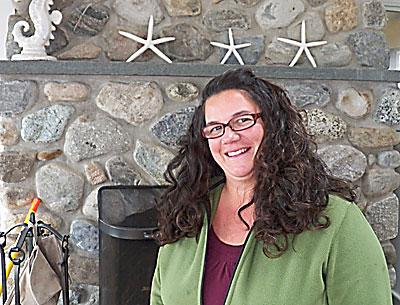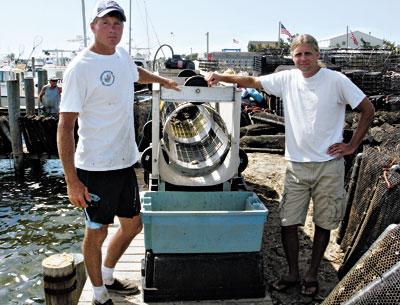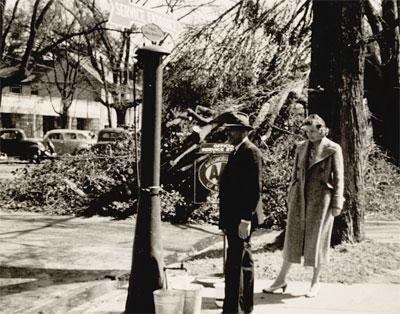The Star Talks to Maureen Rutkowski
The Star Talks to Maureen Rutkowski

If there is one person in Montauk to be thankful for, especially for parents of young children, it’s Maureen Rutkowski. But don’t tell her that, because she’ll only rebuff the statement and make sure everyone else involved gets kudos.
“I’m just the face of a great group of people,” she said from her lakefront house, which is scattered with kids’ paraphernalia — balls, lacrosse sticks, jackets, and other stuff her two children, Alexandra, 13, and John, 9, collect and throw about.
On one wall hangs a sign that says “Good Moms have sticky floors, dirty ovens and happy kids.”
“My family gave me that, and it’s so true,” she said.
She has been the president of Montauk Youth for the last eight years and sends out weekly e-mail blasts to alert everyone on her list to what’s ahead. She is also the only paid administrator of the Montauk Playhouse Community Center Foundation. “That’s my priority,” she says.
When she took over as the president of Montauk Youth, an organization that provides fun events for children and their families including the popular Field Day, she “only continued” the programs begun by the previous administrators, she said. “They had Field Day down to a science. Now we have it down to a science. Parents show up and the first thing they do is ask what they can do to help.”
Among the events since added is a Father’s Day fishing trip aboard the Viking. It was once held a few weeks before the holiday, but it rained so often that they made it a Father’s Day ritual, which has become quite successful.
On Mother’s Day, Montauk Youth oversees the 5K race around Fort Pond and donates the funds raised through registration fees to a needy family in the hamlet. Before the Montauk Food Pantry opened on Tuesday, Montauk Youth sponsored a 5K race around the pond and raised over $1,000 for the pantry.
Ms. Rutkowski also organizes the monthly calendar at montaukyouth.org that she has tweaked to enable other groups, such as the Montauk Library and the Town of East Hampton, to link to and add their own events. She updates it constantly, sends out e-mails to warn people of cancellations, and promotes other activities, such as flag football games. “Whatever we know, we want to spread around; there are so many things happening out here that a lot of parents aren’t aware of,” she said.
The youth group has created a coed flag football game, a spirit squad for children in grades two through five, a roller skating night for the whole family, and a funk squad, choreographed by Joy Hear, that performs routines at various events, including the Sports Night at the Montauk School.
Those scary scarecrows posted all over the hamlet at Halloween? That was Ms. Rutkowski’s idea; she worked with the Montauk Village Association to get it started. She meets often at the playhouse with town officials to go over programs. “We sit with the town and try to fill in the gaps.”
Montauk Youth, she said, supports itself through registration fees, usually $25 per event, and with a $5,000 grant from the Town of East Hampton.
As the administrator for the playhouse, Ms. Rutkowski organizes and updates its calendar as well, at montaukplayhouse.org. It lists all the activities that are offered at the playhouse, especially sporting events in the gym. She reminds people that on Sundays, the batting cage and pitching machine will soon get going with the help of her husband, Dave, and other Little League coaches who will be on hand to help with the budding baseball players.
She meets monthly with the playhouse foundation to brief them on donations, thank-you notes that have been sent, and bookkeeping matters. She enters the information into a database and suggests when a consultant might be needed. She also handles most of the playhouse’s public relations and helps oversee the planning of the annual Playhouse Gala. The gala has become a huge summer event, raising thousands of dollars for the next step of the playhouse project: to get an aquatic center up and running. “We hope to break ground in 2014,” she said.
After the devastation of Hurricane Sandy, Ms. Rutkowski joined the East End Cares effort to help people in the Rockaways, Long Beach, and Island Park. The drop-off center was the Montauk Community Church. A Hampton Jitney donated a bus to transport what had been collected and Ms. Rutkowski said the response was unbelievable. “You wouldn’t believe what that bus looked like,” she said. What didn’t fit into the luggage bin was put on the bus, and a team of residents went along to distribute everything.
East End Cares has created a Facebook page that tells people what’s still needed. Montauk Youth will help with the distribution. “One of the things I like to do is build on the collaboration with all the other Montauk groups,” Ms. Rutkowski said.
Before moving to Montauk full time, she spent summers in the hamlet with her family, mostly camping at Hither Hills State Park. She started working at John’s Drive-In when she was 12; when she was 13, her future husband bought the Montauk eatery. She then went to college, and spent two years in Russia after graduation. “But my friends always knew we’d get married,” she said. And they did, 14 years ago.



